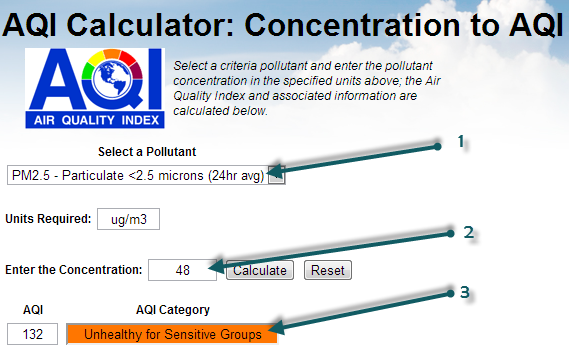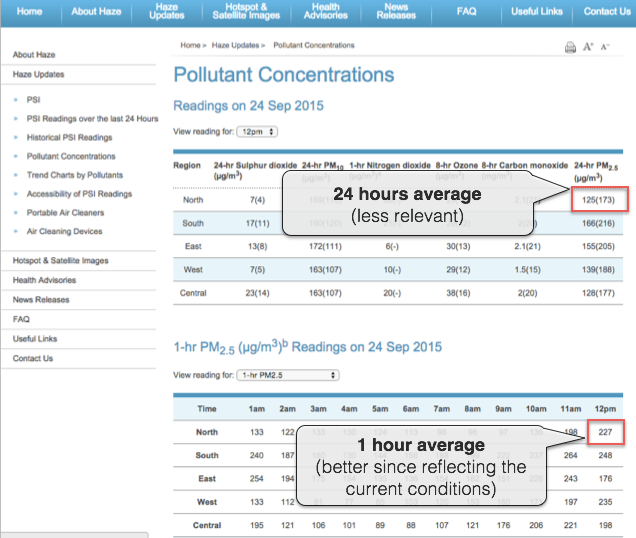In April 2014, the Singapore NEA has updated the PSI calculation to also include PM2.5. http://www.nea.gov.sg/anti-pollution-radiation-protection/air-pollution-control/psi
Nu de recente Zuidoost-Aziatische smog uit Indonesië Singapore en nu Maleisië treft, hebben we veel vragen gekregen over waarom er een verschil is tussen de gegevens die kunnen worden gelezen op de Singapore NEA-website ( nea.gov.sg ) en het World Air Quality Index-project Singapore webpagina .
Dit is bijvoorbeeld wat er vandaag op de NEA-website te lezen is:

Om een of andere historische reden gebruikt Singapore de PSI ( Pollutant Standard Index ) om de luchtkwaliteit te evalueren. In de afbeelding hierboven komt nummer 1 overeen met de PM10-waarde die wordt gebruikt voor de PSI-evaluatie. De waarde 67(/59) kan worden gelezen als 67 μg/m3, wat overeenkomt met een PSI van 59. De PSI wordt geëvalueerd als het maximum van de individuele PSI voor elk van de verontreinigende stoffen: PM 10 , SO 2 , NO 2 , O 3 (Ozon) en CO 2 .
PSI(Singapore-North) = max( PSIPM10-based, ... PSIO3-based )= max (59, ..., 77) = 77
Het interessante is echter dat in dezelfde tabel de PM2,5-gegevens ook in de laatste kolom staan (zie 3). Deze gegevens worden alleen in μg/m3 verstrekt (zie 2), en er is geen conversie naar zoiets als de PSI (dwz een conversie van de PM2,5-massa naar een vervuilings- of kwaliteitsindex). Deze conversie bestaat echter en wordt gedefinieerd door de Amerikaanse Environmental Protection Agency . De eenvoudigste manier om de conversie uit te voeren is door de online calculator te gebruiken, beschikbaar op airnow.gov :

If you select the PM2.5 (1), then enter the mass concentration of 48 (2), can click on Calculate, you will obtain the AQI of 132 (3). So, based on the PM2.5 AQI conversion, the PSI that is used for Singapore could be extended (let's call it PSI++) to also take into account the PM2.5 information. In which case, the PSI++ would be the maximum of the regular PSI (based on PM10 only) and the PM2.5 AQI:
PSI++ = max( PSI, AQIPM.25 ) = max( 77, 132 ) = 132
This PSI++, that is commonly referred as AQI (or Air Quality Index), is what is being used on the the World Air Quality Index project, for all the cities (provided PM2.5 is available for the city). And this explains why the values are different between the NEA website and the World Air Quality Index project.
Moreover, when doing the convertion, make sure you use the 1-hour reading for the PM2.5 concentration rather than the 24-hours averaged value, as shown on the below image:

http://www.haze.gov.sg/haze-updates/pollutant-concentrations/type/PM25-1Hr
If you want to know more about PM10 vs PM2.5, and especially why PM10 is still used, please check the faq entry about why is PM2.5 often higher than PM10? Is PM10 still a relevant measure?
--
For more information about specific countries or continent, please refer to those articles: Thailand and Malysia - India - China - Hong Kong / Canada (Air Quality Health Index) - South America - Australia - Quebec and Montreal - Singapore - Poland - Indonesia .
For information about the 24 hours averaging used or Ozone and Particulate Matter (PM2.5), please refer to those two articles: Ground Ozone Index - PM2.5 Instant Cast
